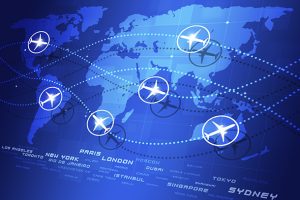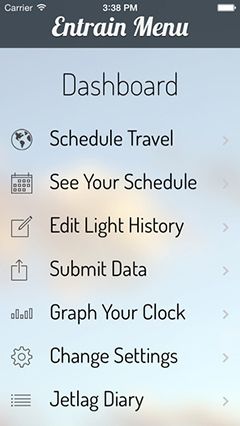An app that helps you beat jet lag: Intriguing, right? Planning for a recent trip to Japan, during which I was going to need to hit the ground running, I decided to try out Entrain, a free app that allows you to monitor your body's circadian clock (its natural daily sleep and waking cycles) and shift it toward a destination time zone to reduce jet lag symptoms. Designed by academics at the University of Michigan, the app gives lighting recommendations (based on your usual sleep schedule, typical daytime light exposure, and particular destination) to help ease your body into a new time zone.
The Power of Light
In search of more details about how light affects jet lag, I reached out to Luc Schlangen, Light and Sleep Scientist at Philips Research. He pinpointed the relationship between light and the circadian clock as one of the most exciting areas of current scientific research on the human body. He explained, "Progress in this area has accelerated since 2000, when researchers discovered a new type of photoreceptor in the eyes, one which powerfully regulates our sleep/wake cycle and our body clock. Through this photoreceptor, light resets our body clock, which prompts our body and organs to carry out their required functions at any time of day."
Setting Up the App
Armed with new confidence about the science behind the app, I began setting up my personal lighting profile. As I started to answer the questions about my daily light exposure, I got more curious about the way it worked, so I called Olivia Walch, the graduate student at UoM who designed the app. She explained that the app was based on a math model that looks at how to adjust a person's personal clock in the least amount of time, using light exposure. She said, "The app is meant to be a mirror of your body's experience." As you're preparing for your trip, you can adjust the app in real time to reflect the light conditions you're actually experiencing, and the app will adjust its recommendations accordingly. "The more accurate you are, the more accurate the model is," Walch told me.
Getting Prepared
After I had submitted all my information, the app displayed the recommendations for how I could adjust my light and darkness exposure in the days before my trip. I was surprised at how extreme the schedule was. Basically, it had set a five-day pattern (you can specify how many days in advance you want to start prepping) of staying in low-light conditions during the day and exposing myself to light at night. This was clearly going to be a logistical challenge.
Light was the key, and from talking to both Walch and Schlangen, I got a better sense of how to manipulate it for my purposes. Schlangen explained, "Under most circumstances, light that is more bright and more rich in short wavelengths, such as blue-rich light, will be more effective than light that is less bright and contains longer wavelengths. As a result, blue light will usually shift the clock more effectively as compared to yellow or red light. Meanwhile, orange-tinted or red glasses absorb blue light. By reducing blue light exposure, orange-tinted or red glasses also reduce the resetting action of any light exposure."
While Walch assured me that no extra supplies were necessary, I thought I'd have better luck with tools that could help me mimic day and night. In the evening hours when I was supposed to be near light, I used the travel-friendly Philips GoLITE BLU. It's about the size of a tile, it comes with its own carrying case, and it delivers intense blue light that most people use to boost energy or manage winter blues. To make daytime less bright, I bought a pair of cheap orange safety glasses off Amazon and wore them during the day.
Using the App
I was up for the challenge of alternating between sunflower and vampire in my light pursuits, but I quickly realized it's really hard to switch night and day. Sleeping with a light on, I couldn't settle into sleep easily and I seemed to wake up more. Not to mention that my husband, who was not traveling, had trouble with the light-on sleep model. After two nights of sleeping with the light on (I abandoned the blue light for overnight use after the first night and opted for a small lamp on the floor next to my side of the bed), we both felt a bit, well, jet-lagged. Throughout the week, I felt mild sleepiness randomly during the day and had an occasional headache that I assume was related to the weird sleep schedule.
During the day, I was supposed to be in darkness. But, practically speaking, it's a challenge—particularly in the days leading up to a trip—to drop everything and sit in a dark room all day. That's where the safety glasses came in very handy. I used them while I worked (computers and other screens emit blue light) and around the house but opted out of wearing them while driving (because that seemed dangerous) and while running errands (because I didn't want to freak people out).
The Results
Tokyo, where I landed, is 17 hours ahead of my departure point of San Francisco. That time difference is a recipe for serious jet lag, as I had discovered on my first trip to Japan decades ago. And when I landed at what was midnight at home, I was feeling pretty beat. But the next morning, I woke up and felt … normal. I dragged slightly that afternoon, but I rebounded by dinner, and by the next morning, I felt like I had been in my new time zone for weeks. I was amazed—and happy that the hard work, slight inconvenience, and mild discomfort during my pre-travel adjustment period had paid off.
General Time-Shifting Guidelines
I like the app because it took my personal sleep schedule (early to bed, early to rise) into account and told me exactly when I should be shifting between light and dark. But Schlangen gave me some general guidelines that offer a bigger-picture view of the approach:
When Flying West: "If you are flying west, your body clock will need to be delayed so you feel less jet lag upon arrival. Depending on the number of time zones you plan to cross, you can decide to start delaying your body clock one or two days prior to your departure. Delaying the clock is best done by seeking blue-rich light in the later part of your evening to keep you awake and staying up a bit later. However, it is important to keep in mind that the definition of "evening" depends on your regular bedtime. It can mean 9 p.m. for some people but 12 p.m. for others—it's very subjective. Next, minimize any light exposure in the earlier part of your morning, either by wearing sunglasses or sleeping in a bit longer into the morning.
"You can also start resetting your clock only upon arrival as well, but then you should bear in mind that maximizing and minimizing light exposure needs to be done late in the evening and early in the morning at your departure point, respectively."
When Flying East: "If you are flying east, your body clock needs to be advanced. Advancing the body clock is best done by seeking light earlier in your morning, for instance by waking up (with an alarm clock) a bit earlier than usual. Combine that with minimizing blue-rich light exposure in the later part of your evening by wearing sunglasses or going to sleep earlier. You can also start resetting your clock only upon arrival as well, but minimizing and maximizing light exposure needs to be done late evening and early morning at your departure point, respectively."
You Might Also Like:
- Cures for the Travel Hangover
- 11 Secret Natural Cures for Travel Ailments
- Considering a Round-the-World Trip? Read This First
This article was originally published by SmarterTravel under the title Can You Outsmart Jet Lag with an App? Follow Christine Sarkis on Google+ or email her at [email protected].
(Photo: Thinkstock/iStock and Entrain)







